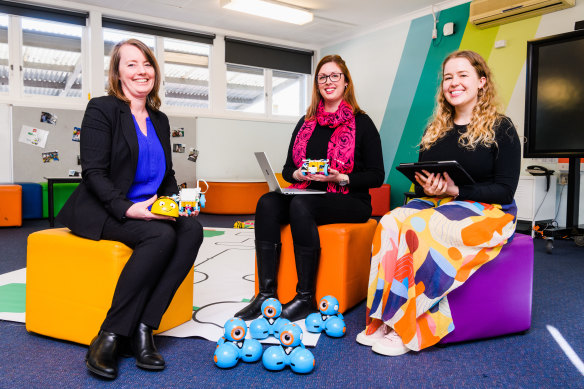By Liam Mannix
The number of young women enrolling in science and maths in year 12 has nearly reached parity with young men, but while the battle for the minds is being won at school, jobs in these industries continue to be dominated by men.
Girls now make up 52 per cent of science enrolments and 48 per cent of mathematics enrolments in the final year of school, new government figures show. They have also passed boys in agriculture and environment sciences, earth sciences and chemistry – with female participation in the latter subject growing from 49 per cent in 2013 to 51 per cent.

Alix Ratcliffe and her team teach Future You a module that encourages young women to consider studying STEM subjectsCredit: James Brickwood
This follows decades of work to equalise a stubborn gender gap, based on stereotypes about “boys jobs” and “girls jobs”.
“I’m personally very encouraged and very excited that we’re seeing genuine progress,” said women in STEM ambassador Professor Lisa Harvey-Smith.
More than a third of students studying science, technology, engineering and mathematics (STEM) subjects at university are women, while women also outperform men in STEM subjects at university on average.
However, many don’t make the leap into STEM jobs, sometimes because they don’t feel safe in male-dominated industries.
The proportion of women in STEM-qualified occupations was only 15 per cent in 2022, up from 10 per cent two decades ago in 2002. And women in STEM are paid $27,012 less than men on average, a wider-than-average pay gap.
Other indicators also continue to lag. Girls’ confidence in STEM subjects falls as they get older. As maths gets harder towards the end of year 12, fewer girls enrol. And they remain underrepresented in IT, engineering, physics and astronomy.
Fewer than a quarter of year 12 students enrolled in technology and engineering are girls.
“It’s a bit like steering the Titanic,” said associate professor Merryn McKinnon, a researcher at the Australian National University who studies the issue.

The data showing girls participation in science in the classroom is promising.Credit: iStock
“We’ve gone for the low-hanging fruit in what we can do that’s quick and easy. But now we need to sit down and have some uncomfortable conversations.”
Since 2015, the federal government has been ramping up investment in cutting the gender gap in STEM. Almost $150 million has been spent on programs, such as the women in STEM ambassador initiative.
The ambassador’s Future You program targets stereotypes about gender and work in children as young as eight by giving teachers short films and teaching packages showing women working in different STEM jobs.
“Our society is incredibly gender-stereotyped. At the age of three or four we are infusing our children [with] gender stereotypes – literally just by referring to them as boys and girls. That’s where we start imprinting,” said the program’s manager Hilary Schubert-Jones.

An Amazon Echo Dot.Credit: AP
She encouraged parents to think about their smart speakers, which usually use female voices. “It’s the servitude thing - women are serving. And a woman’s place is in the home.”
Switch them to male voices in settings, she suggested.
Almost all Australian programs to encourage gender equity in STEM have shown no evidence they are working, a 2020 study found.
Nearly all those programs focus on school or university, when the data suggested it is industry that really needed to change to welcome women.
“When it comes to workplaces, we still have a long way to go to a real systemic structural approach about promoting and retaining women in the workforce,” said Dr Janin Bredehoeft, chief executive of Science in Australia Gender Equity.
Part of the problem is that some women often don’t feel safe working in male-dominated industries, as they worry about bullying, sexual harassment and not fitting in.
“They don’t want to work in it. And their parents and teachers are encouraging them not to work in it because it’s gender segregated,” said Harvey-Smith.
“In gender-segregated industries, safety is a key factor for women. In more gender-balanced industries, bullying, sexual harassment are lower. That’s just a fact.”
Liam Mannix’s Examine newsletter explains and analyses science with a rigorous focus on the evidence. Sign up to get it each week.